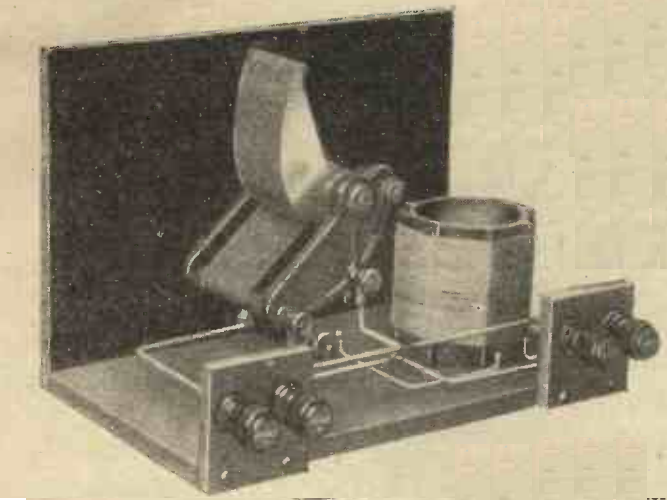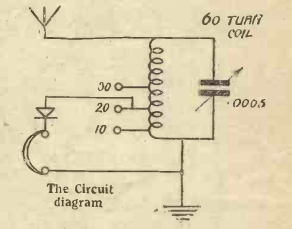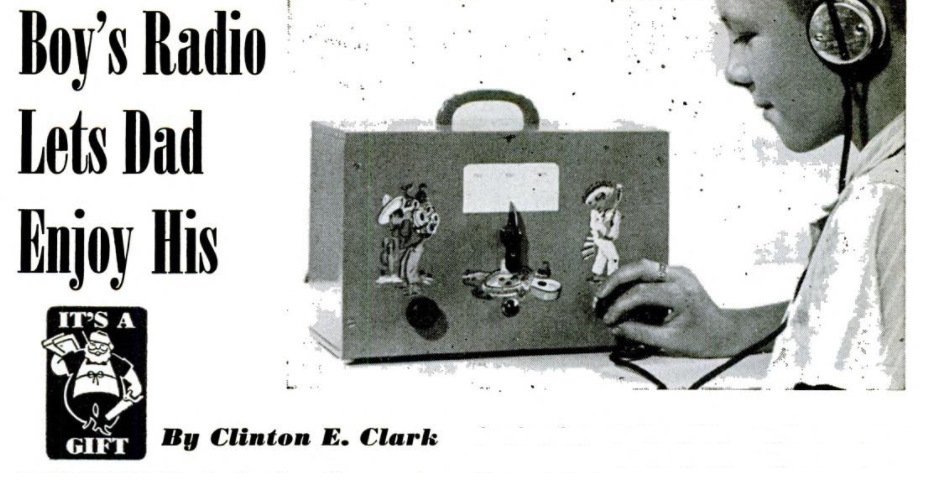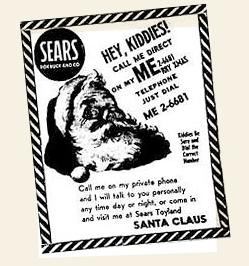 This self-explanatory image appeared on the cover of Radio News 90 years ago this month, December 1927.
This self-explanatory image appeared on the cover of Radio News 90 years ago this month, December 1927.

 This self-explanatory image appeared on the cover of Radio News 90 years ago this month, December 1927.
This self-explanatory image appeared on the cover of Radio News 90 years ago this month, December 1927.
 The plans for this British crystal set appeared 90 years ago in the December 17, 1927 issue of Amateur Wireless.
The plans for this British crystal set appeared 90 years ago in the December 17, 1927 issue of Amateur Wireless.
The set was billed as an ideal Christmas gift for someone living close to a BBC station. “A receiver such as this is inexpensive to build and would make an admirable Christmas gift to someone who lives near a B.B.C. station and has facilities for the erection of a reasonably efficient aerial-earth system.”
 According to the article, if the set was equipped with a good aerial and earth, it would work two pairs of headphones with good volume, at a range of up to 12 miles from a main BBC station, or about half that distance from a relay station. The set was simple to operate, since it used a “permanent” crystal detector.
According to the article, if the set was equipped with a good aerial and earth, it would work two pairs of headphones with good volume, at a range of up to 12 miles from a main BBC station, or about half that distance from a relay station. The set was simple to operate, since it used a “permanent” crystal detector.
The article used quotation marks, since apparently the detector (available from either R.I. and Varley, or the Jewel Pen Company) was capable of an initial adjustment. “When testing on actual reception, carefully adjust the crystal detector until loudest results are obtained, and then leave well alone, as far as the detector is concerned.”
 Seventy years ago, Santa was getting ready to head down the chimney with some of these Philco radios and phonographs shown in this ad from the December 15, 1947, issue of Life magazine.
Seventy years ago, Santa was getting ready to head down the chimney with some of these Philco radios and phonographs shown in this ad from the December 15, 1947, issue of Life magazine.
The featured console was the Philco 1270, with a list price of $359.70. It featured an FM tuner, and also promised to let you say goodbye to record noise, with the “Philco Electronic Scratch Eliminator, the device that separates noise from music for the first time in the history of record-playing.”
If you wanted to add some scratches to those records to test the capabilities, the ad also featured two phonographs that could probably do the trick, models 1200 and 1201. The record was inserted into a slot on the front, and the ad promised “no more fussing with lids, tone-arms, or controls.” Model 1200 was just a record player, while model 1201 also featured a radio. Both were portable and could be carried anywhere.
You can see the 1270 in action at the following video. While not mentioned in the ad, you can see from the video that the set also tuned 6-15.5 MHz shortwave.
 While this project from the November 1947 issue of Popular Science is ostensibly a Christmas present for Junior, the text of the construction article reveals that Mom and Dad might have an ulterior motive: “Everyone in the family will enjoy this little two-tube headphone set. Junior can listen to all the programs especially meant for him, and Pop and Mom will escape the nerve-shattering tommy guns and thundering herds.”
While this project from the November 1947 issue of Popular Science is ostensibly a Christmas present for Junior, the text of the construction article reveals that Mom and Dad might have an ulterior motive: “Everyone in the family will enjoy this little two-tube headphone set. Junior can listen to all the programs especially meant for him, and Pop and Mom will escape the nerve-shattering tommy guns and thundering herds.”
The set is a two-tube regenerative receiver for the broadcast band, using a 12J7GT detector with a 12J5GT serving as audio amplifier.
It’s an AC/DC set, meaning that Junior should probably make sure he doesn’t use it close to the water pipes. It appears to be electrically isolated from the chasis, and as long as capacitor C8 doesn’t short out, the headphones will be isolated from the AC line.
To tame the regenerative receiver, and keep Junior from becoming a squeal hound, the controls are preset, and tuning is accomplished with three or four trimmer capacitors set to local stations, and a switch is used to pick the station.
No external ground is used (probably to keep the AC-DC set from blowing a fuse or zapping Junior). The article notes that an outdoor antenna is desirable but not absolutely necessary.
Merry Christmas from OneTubeRadio.com!
A hundred years ago, Santa brought this family a Victrola, the only instrument that could bring the world’s greatest artists, such as Caruso or Paderewski. The ad promised that nothing would bring so much pleasure to family and friends throughout the year. Prices ranged from $10 to $400, and dealers in every city in the world would be happy to give a demonstration.
 The ad appeared in the December 14, 1916, issue of Youth’s Companion, which also carried this ad, indicating that Santa would be giving some youngsters an introduction to wireless. This ad promised that a wireless set would keep a boy busy, and arouse the inventive scientific instinct in every red-blooded American boy. Prices for a beginner’s wireless set from the Doubleday-Hill Electric Company of Pittsburgh ranged from $10 to $50.
The ad appeared in the December 14, 1916, issue of Youth’s Companion, which also carried this ad, indicating that Santa would be giving some youngsters an introduction to wireless. This ad promised that a wireless set would keep a boy busy, and arouse the inventive scientific instinct in every red-blooded American boy. Prices for a beginner’s wireless set from the Doubleday-Hill Electric Company of Pittsburgh ranged from $10 to $50.
Caruso’s only Christmas recording was O Holy Night (Cantique de Noel). It was recorded on February 23, 1916, and a hundred years ago, Christmas 1916. would have been the first time it was heard.
I’m not sure how practical the idea was, either then or now, but the December 1926 issue of Radio News offers this suggestion to turn your Christmas tree into a Loudspeaking Christmas Tree.
According to the accompanying construction article, authored by none other than publisher Hugo Gernsback himself, “a Christmas tree and music are almost synonymous.” For some years, Gernsback had been wondering why the self-evident idea of combining the tree’s scent with a radio has not been more universal.
The idea shown here killed two birds with one stone, by providing not only a base for the tree, but also make the tree musical.
Merry Christmas from OneTubeRadio.com!
We look back to 1940, as America celebrated its last prewar Christmas. The December 23 issue of Life Magazine proclaimed that “forgetting war and stringing holly, U.S. spends to make Christmas jolly.” The magazine reported that despite the clouds of war, American preparations for Christmas “reflected no hint of anything but peace, prosperity and goodwill.”
But the magazine also noticed a mood that contrasted significantly with Christmases of other years. Gone were the Yules filled with the fragrance of evergreens, candles, carols, still snows, and silent skies. Instead, it was filled with streamlined, mass-produced mechanical Santas of identical image grinning and nodding in department store windows. Decorators did tricks with electricity and plastics. Comic strip characters and bathing beauties intruded on a show previously dominated by the Magi and the Virgin Mary.
It said that the new mood wasn’t hard to explain, as the nation had lived with the threat of war for fifteen months. “Only in excitement, in spending, could America forget Coventry, Birmingham, and Alolf Hitler.” And there was a lot of money to spend. With war industries gearing up, Americans were flush with cash.
Click Here For Today’s Ripley’s Believe It Or Not Cartoon
![]()
This recording of O Holy Night (Cantique de Noel) from February 23, 1916, was Enrico Caruso’s only Christmas recording.
 As you are probably aware, each Christmas, the North American Aerospace Defense Command (NORAD) tracks Santa Claus as he travels around the world. Obviously, there’s a practical reason for this. If his supersonic travels were mistaken for something else, then the results of the error could be quite dramatic, to say the least.
As you are probably aware, each Christmas, the North American Aerospace Defense Command (NORAD) tracks Santa Claus as he travels around the world. Obviously, there’s a practical reason for this. If his supersonic travels were mistaken for something else, then the results of the error could be quite dramatic, to say the least.
NORAD first began sharing this information with children 60 years ago, in 1955. Initially, this was the result of another mixup, albeit a less dramatic one. A Sears store in Colorado published the ad shown at the top of the page, purportedly showing Santa’s previously unlisted telephone number. Unfortunately, the ad carried the wrong number. Instead of Santa’s number, the store had listed the number of the Continental Air Defense Command, NORAD’s predecessor. Initially baffled, the officer answering the phone ultimately figured out what was going on, and had his men check the radar. He then gave reports of Santa’s current location.
NORAD now uses the Internet to disseminate this information, which is available at NoradSanta.org.
Click Here For Today’s Ripley’s Believe It Or Not Cartoon
![]()